      
Iran:
A female revolution*
A monumental challenge to Islam
Azar Majedi
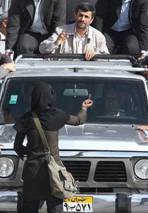 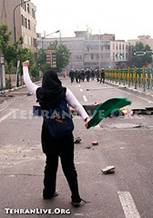 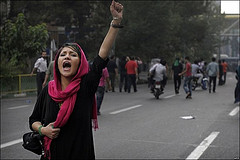
What we are witnessing in Iran is not only a movement against a dictatorship and for political freedom; it is not only a movement against poverty and socio-economic injustice and for equality and prosperity; it is a movement against religious institution, hypocrisy, corruption and superstition. In this context, it is for cultural and moral emancipation as well. The political uprising in Iran has a strong anti-religious character.
30 years of religious oppression has created a generation, which wants to emancipate itself from any religious domination, restriction or meddling. 30 years of imprisonment by a brutal religious state, which has interfered in the most private spheres of people’s lives, a state run by the most greedy, corrupt and dehumanized men of god, has created a society ready to de-religionise itself and ready to rid itself of religious rules and customs. Iran is on the verge of a new age of Enlightenment.
Women’s liberation movement: a revolutionary force
The women’s liberation movement is the most important player in the fight against the Islamic Republic. WLM is the antithesis of the Islamic regime. The Islamic regime promotes a misogynist ideology. Subordination and enslavement of women is its credo, the Islamic veil is its flag and gender apartheid is fundamental to its political system. WLM is not able to achieve any significant advancement without first doing away with this regime. The women’s liberation movement in Iran embodies a revolutionary liberating force.
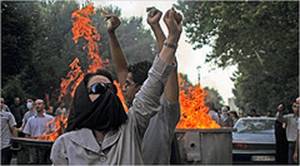
In the struggle for women’s freedom and equality, the women’s liberation movement transfers the society as well. A society where women are free and enjoy equal status will not tolerate religious tyranny or religious rule. As Marx so brilliantly put it: “the measure of a society’s freedom is women’s freedom.” The women’s liberation movement in Iran is the epitome of this. The high status of the women’s liberation movement in the society and the resilience with which it has carried out an extremely difficult struggle validate this thesis.
Women proved to be a prominent opposition force to the Islamic regime. The first large demonstration against the regime was organised by women and for women’s rights. Khomeini’s ruling on compulsory veiling for female employees gave rise to an immediate protest on the streets of Tehran and some other large cities on 8 March 1979 followed by a week of demonstrations, mass meetings and sit-ins by thousands of women. They managed to inflict the first national defeat on the regime. This was the beginning of a thirty-year tense and hostile relationship between women and the regime.
The Islamic republic was forced to define its main character vis-à-vis the women’s liberation movement. Its ideological and moral war against women has been one of the most demanding battles it had to wage. Women’s issues never left the political scene. Ever since its inception, it had to deal with women’s demands. Many women as well as men have lost their lives or suffered immensely for challenging the misogynist order and for defying the rules of gender apartheid.
By fighting a long and hard battle against the most misogynist political system in the modern history, the women’s liberation movement in Iran has become an impressive and strong force with remarkable liberating potentials. The women’s question proved to be the Islamic regime’s Achilles heel. The irony is that those who the Islamic regime regarded as sub humans, worthy of men’s slaves, have come to the streets and are fighting it tooth and nail. This movement has far-reaching potentials. It would not only liberate women in Iran but also open up a whole new door to women in the region and in societies living under the grip of Islam. The women’s liberation movement has come to haunt the Islamist movement.
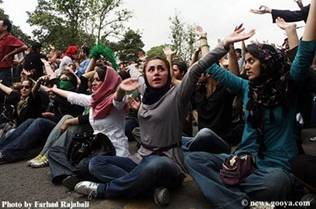
Islam being challenged as never before
The political uprising in Iran has already touched the whole world. The role women are playing in it has stunned the world. The developments in Iran have challenged what we were told by the mainstream media and academia about Iranian society and its socio-political and cultural fabric. Repeatedly we have been told that Iran is an Islamic society; people are not against the Islamic republic or Islamic rules and customs. They only want some minor changes.
Believing this would have led us to regard the people in Iran as some masochist bunch who like to be tortured to practice “their culture and beliefs.” Otherwise, why was such a sophisticated system of oppression and torture necessary? The cases of executing people by cranes on the streets, stoning women and men for engaging in sex outside marriage, flogging women for not observing the Islamic dress code are so abundant; a large army of thugs is employed to oversee that Islam is observed. Facing these known facts about the Iranian society would discredit all these superficial assumptions by “Iran experts.” A very simple question would come to mind: If people wanted to practice Islam then why has such display of brutality become necessary?
People in Iran are freeing themselves from the rule of religion. They are rebelling against a religious tyranny and all interference of religion in their lives. People’s uprising in Iran will do to Islam what the French Revolution did to Christianity and the Church in the West. Just as the coming to power of an Islamic regime in Iran was a great boost to the Islamic movement and Islam as a religion/ideology, the overthrow of it will too be a great blow to this reactionary, misogynist and brutal movement. The political events in Iran thirty years ago transformed Islamists from a marginal political force to a major force, which came to play an important role in the regression of the societies under the grip of Islam, particularly the situation of women. The 1979-defeated revolution in Iran was a renaissance of the Islamic movement.
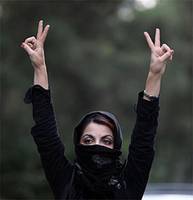 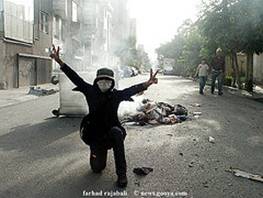
Islam’s renaissance as a “liberation ideology”
Islam as a religion and ideology and the Islamist movement owe their renaissance to the coming to power of an Islamic regime in Iran. The circumstances in which the Islamic regime gained power in Iran were a major factor. Coming to power as a result of a popular uprising against the most devoted ally of the Western powers, known as an American ”puppet”, gave Islam an ideological impetus, previously unknown. In order to maintain its power, the Islamic regime was forced to take on a “militant” anti-American stance. The Islamic regime’s existence has very much depended on this so-called anti-imperialist façade.
In 1979 Iran, the left was popular. The larger section of the left was populist in its character and it could therefore easily fall for any anti-American act. The Islamic regime had different factions from the beginning. The faction, which planned the occupation of the American embassy, saved the regime from the increasing leftist, workers and women’s protests and assaults. This action disarmed the populist left. Resorting to the well-known tactic of creating an external enemy to unify the masses behind it, in addition to stage-managing a fight against the USA, saved the regime in Iran and raised its profile as an anti-imperialist force regionally as well as internationally.
In the 1980s when the established anti-imperialist traditions were loosing momentum and facing ideological defeat (the collapse of state capitalism in Soviet Union and the Eastern block) the new Islamic movement presented itself as a viable substitute. Islamists as a backward trend had long opposed modernization process in the region and were against Western values and culture. The anti-Western sentiments of the Islamic movement corresponded with the nationalist, anti-colonialist tendencies of a section of the intellectuals in the region.
The process by which the Islamic Republic came to power in Iran, gave rise to a new Islamist trend, a so-called anti imperialist trend which offered its own kind of “liberation theology” to the masses of the people who lived under brutal dictatorships supported by Western powers. Furthermore, the demagogic populist propaganda used by this movement helped falsify a totally inhuman, misogynist and backward ideology as a so-called “liberation ideology.”
Indeed the international situation has helped it a great deal. Islamists have risen to a formidable position of a pole in opposition to a state terrorist pole led by the USA. These factors explain the appeal of the Islamist movement for sections of the masses and the young generation in the Middle East and North Africa who are fed up with the corrupt dictatorships under which they are forced to live, by Israel’s daily humiliation of Palestinians and the abuse of their rights, and finally by the war on Iraq.
In a void of alternatives, in a situation that any progressive and humane organisations are banned, Islamists succeeded to present themselves as a force that voices people’s grievances. In societies where poverty is rampant, living conditions are appalling and inequality, discrimination and injustice are commonplace, the complete absence of any freedom to express discontent, protest or organise for change, leaves people no choice, but to resort to the only option available, i.e. the Islamist movement. Moreover, certain so-called left-wing trends, which so readily ignore any violation of basic civil rights and economic rights of the people in order to fight America, support this brutal, reactionary and misogynist regime. For thirty years, this regime has financially, ideologically and morally supported a terrorist movement, which has terrorized, first and foremost, the people in the region. Therefore, a fight against the Islamist movement and Islamism is a political fight as well as an ideological one. The uprising in Iran is capable of leading this fight in both fields.
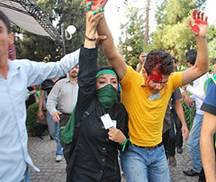 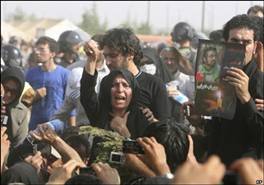
Iran 2009, France 1789
Islam has never experienced a challenge similar to the one Christianity faced in18th century Europe. The uprising of the people in Iran against the Islamic regime tears this perverted liberation theology to shreds. Events in Iran are not only pulling down a political system, they are also revolutionizing the mindset of the world vis-a-vis Islam and the role Islam plays in the societies under its grip. This process has been facilitated and expedited by one important factor, the fact that, thanks to new technology and the technology-savvy young generation in Iran, this uprising is unfolding in front of the eyes of the whole world. People of the world have seen live how people, particularly women in Iran have come to the streets defiant of batons, tear gas, warm ammunition, brutal torture and gang rapes to demand their freedom. It is no accident that Neda has become the icon of people’s uprising in Iran; the young woman whose tragic death on a street of Tehran was captured on a mobile phone and transmitted to the homes of millions around the world. Neda became the symbol of people’s resilience and bravery. She became the icon of a female revolution against a regime, which regards women as half-human.
Those supposedly weaker and ‘half human’ women are challenging, not only a misogynist system, but Islam as well. They are led by their great aspirations for freedom. Even if the fear of a brutal dictatorship does not allow them to express freely what they want; even if 30 years of oppression and censorship has created an involuntary defensive cap inside their minds, as a self-censorship sensor to limit their scope and aspirations; the aspiration for a total emancipation lives in them and has been awakened. Even if the invincible appearance of the regime had forced them to resign to pragmatism and balance of power for three decades, they have overcome their fear and are challenging the force of intimidation.
Women in Iran sent shivers down the spine of the Islamic fundamentals. The long struggle against the Islamic Republic and for equal rights and freedom has not spared Islam. The young generation, particularly women have repeatedly ridiculed the religious ceremonies and sanctities. In their fight against gender apartheid, they have gone as far as breaking the rules and ‘sacredness’ of the Friday prayer.
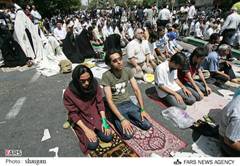
One of the most important fundamentals of Islam is gender apartheid. This principle permeates all religious dogmas and rules. Prayer, itself a pillar of Islam, must stay sexually segregated at all costs; the rationale behind this is that the sight of a woman arouse men sexually and therefore lead them to sin and spoil their precious moments with god. In Friday or mass prayers, women and men are completely separated, even though women must be veiled and covered from head to toe. What is very ironic is that women must be veiled even when they pray alone, that is, when they are alone with god. One cannot help but think that this is prescribed to save god from sinning!
But Friday July 17 was an exception in the history of Islam. On this day, a historic event took place in Tehran. On July 17, Hashemi Rafsanjani, a leading and prominent figure in the Islamic Republic, addressed the Friday prayer. Rafsanjani is an opponent of Ahmadinejad and a tacit supporter of Mir Hossein Mousavi. This day arrived in a climate of great anticipation. Since it was announced that Rafsanjani was to address the Friday prayer, speculations began circulating over what he would say, whom he would side with and the aftermath of the prayer.
The state reformist tendencies begged him to “stand firm.” The international media discussed him and his family’s positions and history. “The Iran Desks” became saturated with Rafsanjani’s info. It was self evident that he would by no means discredit the Islamic regime, without which he would fall from power, and risk loosing not only his monumental wealth which he has amassed in the past thirty years, but also his freedom. He is among the top list of the Islamic regime’s leaders whom people want to bring to trial for crimes against humanity.
Rafsanjani did not say anything extraordinary. However, Friday July 17, 2009 became a historic day not only in the history of the Islamic Republic, but Islam itself. A large rally took place in Tehran. Women and men together walked towards the University of Tehran, where the Friday prayers take place. Close to the university, the crowd had to pray to justify their assembly there. On that day, the world witnessed a mixed-sex prayer in Tehran. Many women with a small veil on their heads, with makeup, along with male protestors joined the prayer ceremony. In this respect, Friday 17 July was a turning point in political developments in Iran.
In these intense political developments, Islam’s sanctity is being stripped away. People’s mockery has spared no divine laws in Islam. The clergies are the most despised section of the society. Religious institution is regarded as the most corrupt, greedy and untrustworthy social, political or ideological institution. The folklore is full of stories to discredit the clergy as hypocrites, backstabbers and thieves. Most jokes in Iran today target the clergy and Islamic system.
Once this regime is down to its knees, all signs of Islamic domination and laws will be dismantled. The society will hail its emancipation from religious dominance. Politically, secularism will be enshrined in the country’s constitution. Socially, an anti-religion trend will dominate. In culture and art an avant-garde movement for enlightenment flourishes. And all these will have far-reaching effects transcending borders. The uprising in Iran will revolutionize the socio-political climate of the region. A marginalized Islam in Iran will be a great assault to Islam and its sanctity internationally.
1 August 2009
* Mansoor Hekmat coined this expression in a seminar entitled: “Will Communism succeed in Iran?” At Marx Society, London, February 2001.
|

